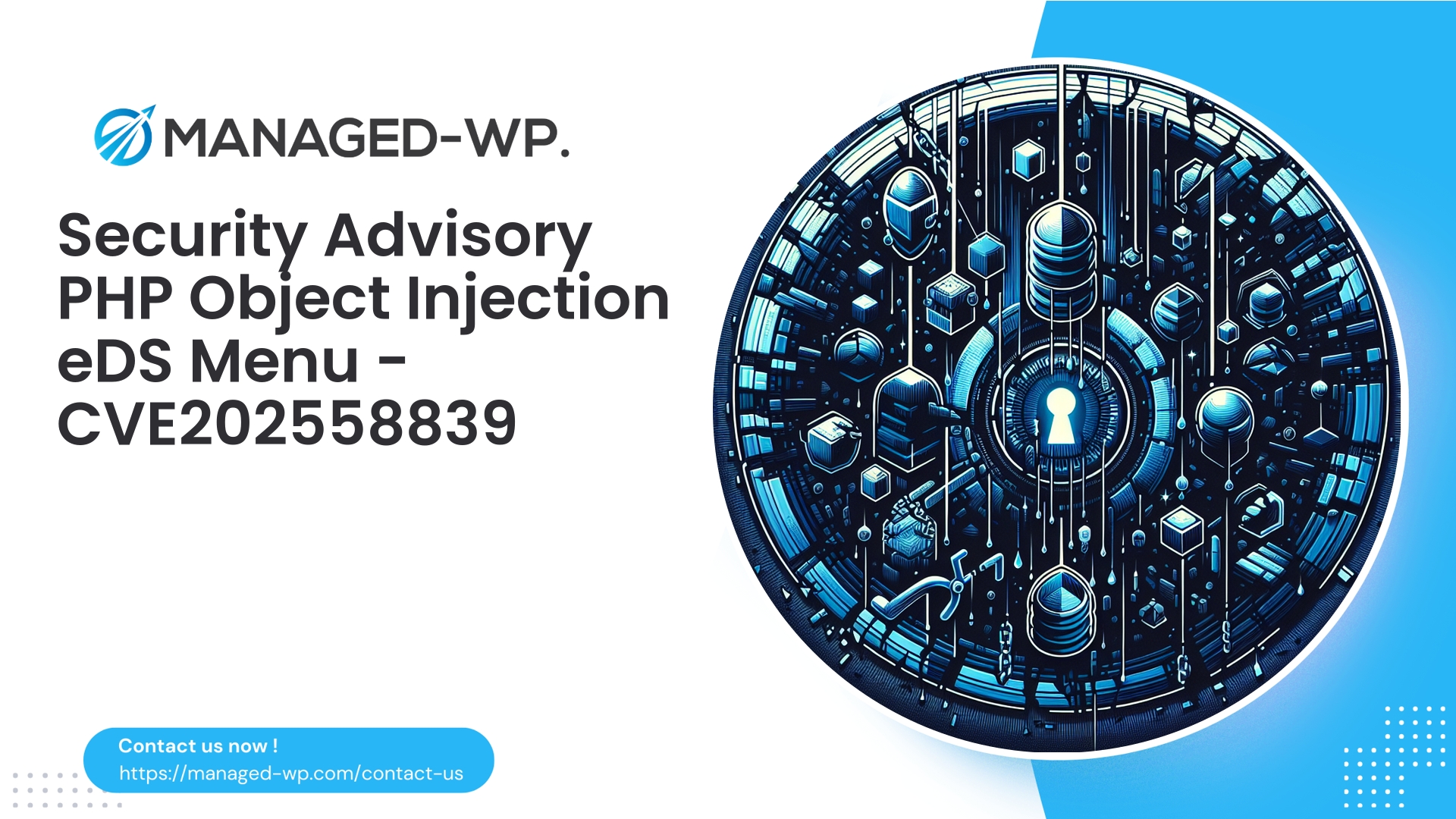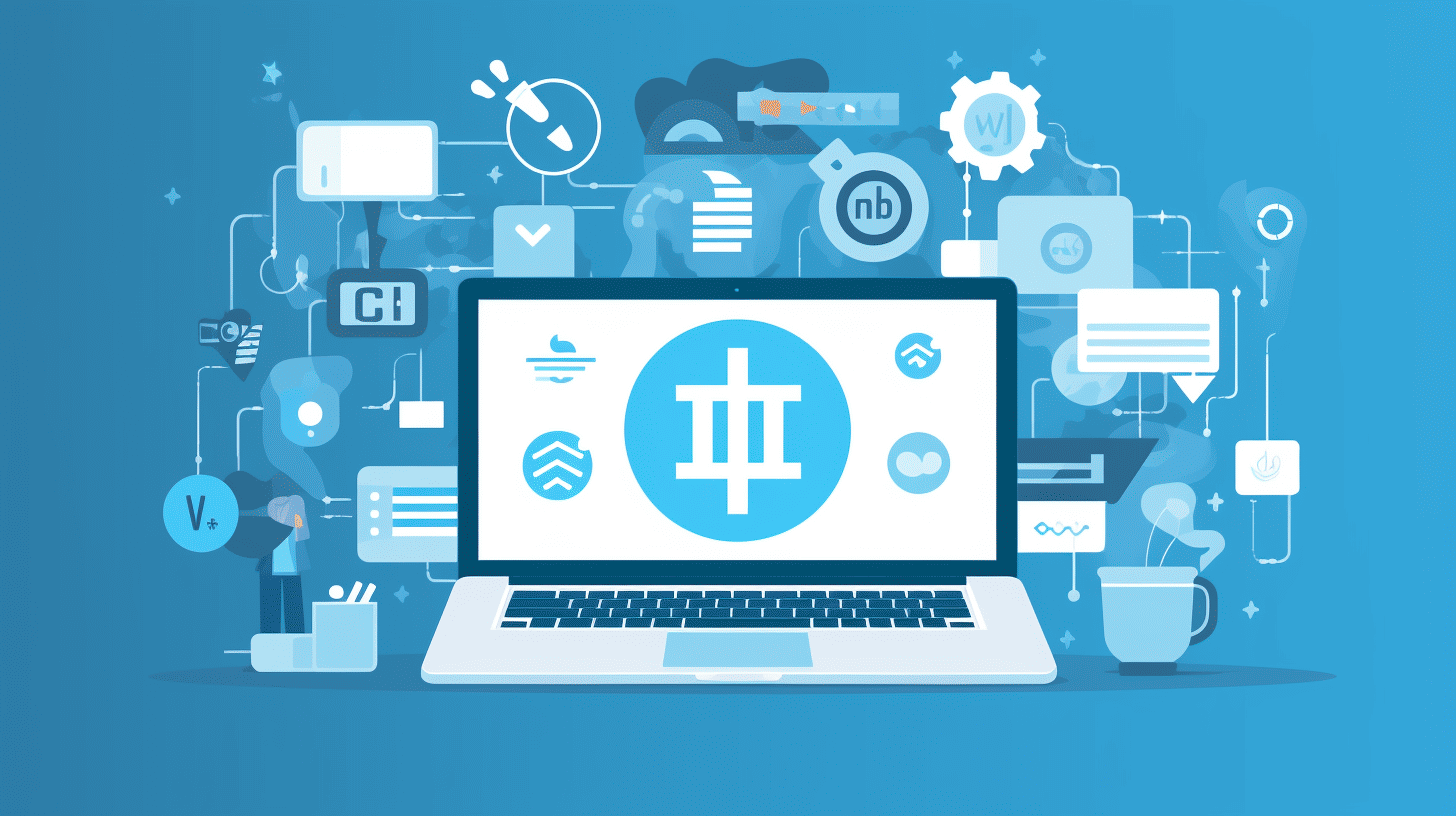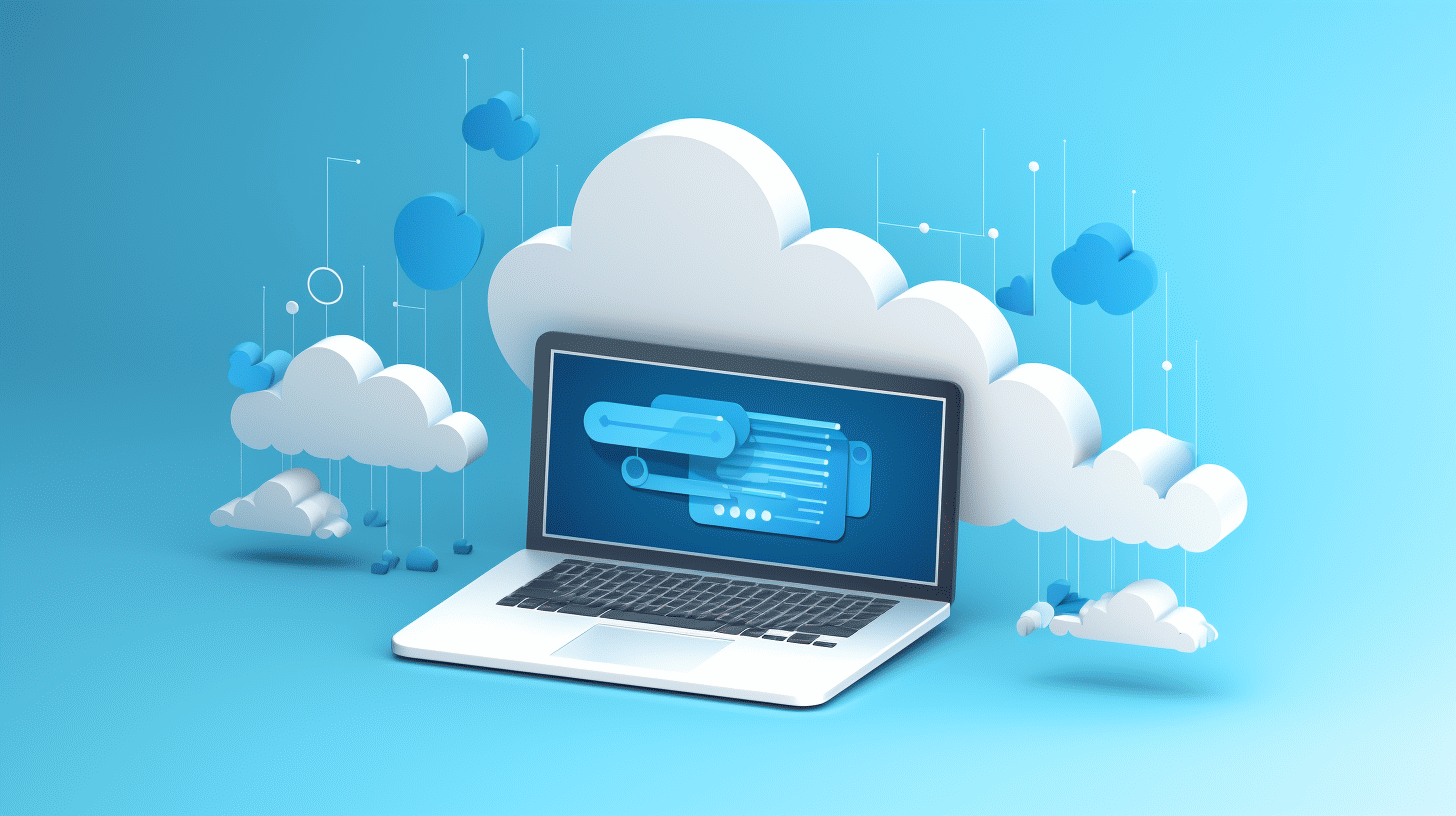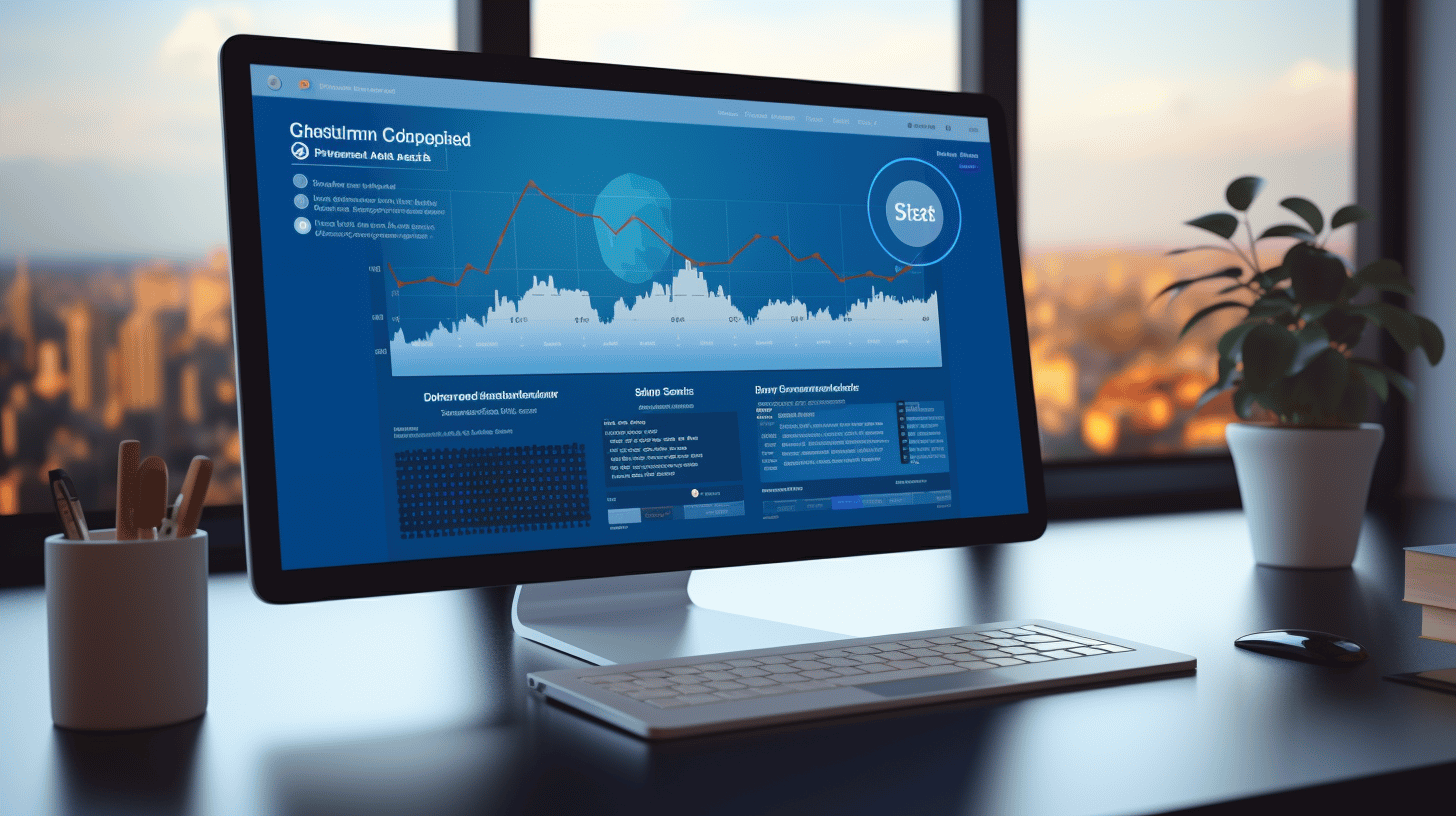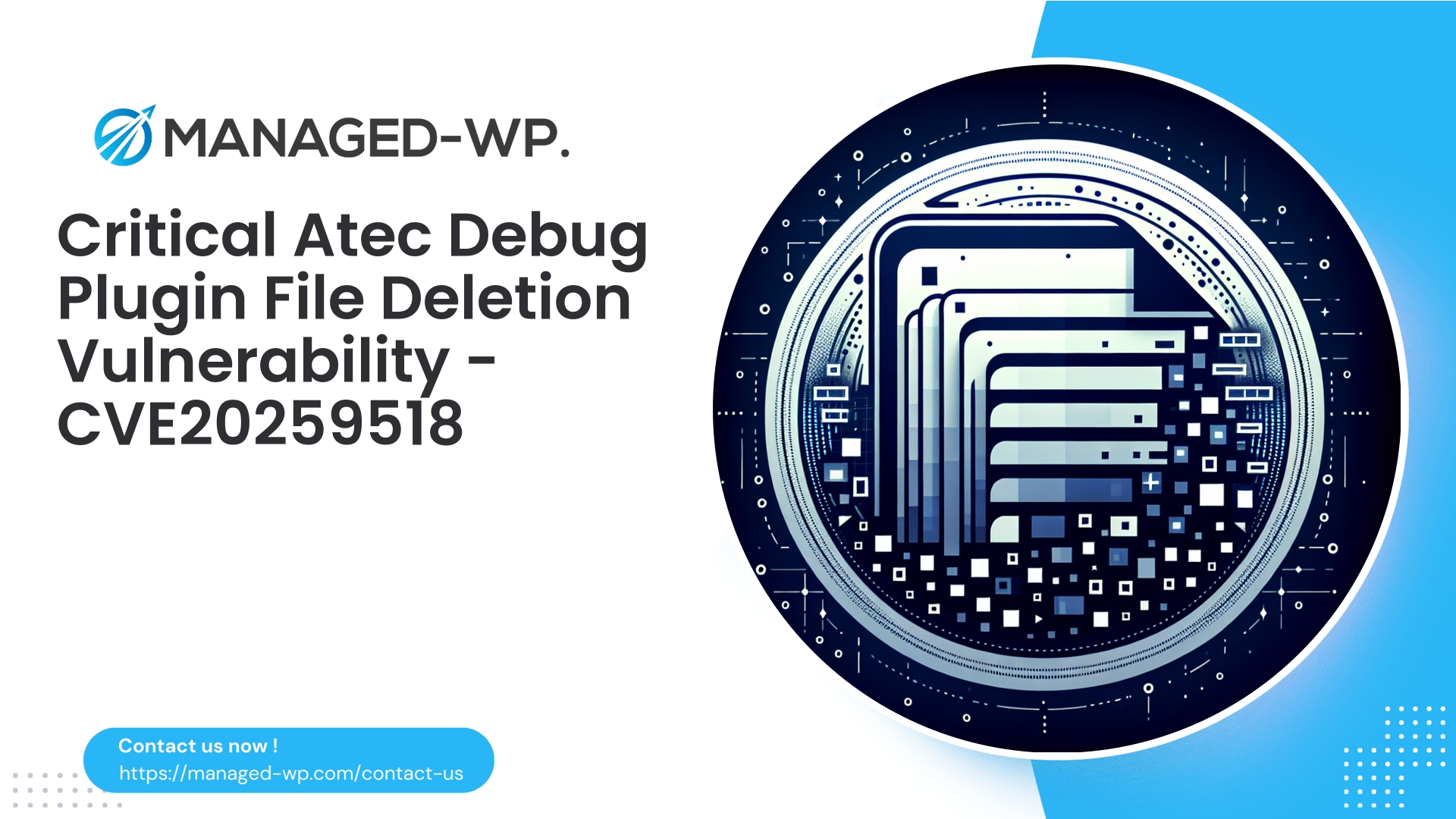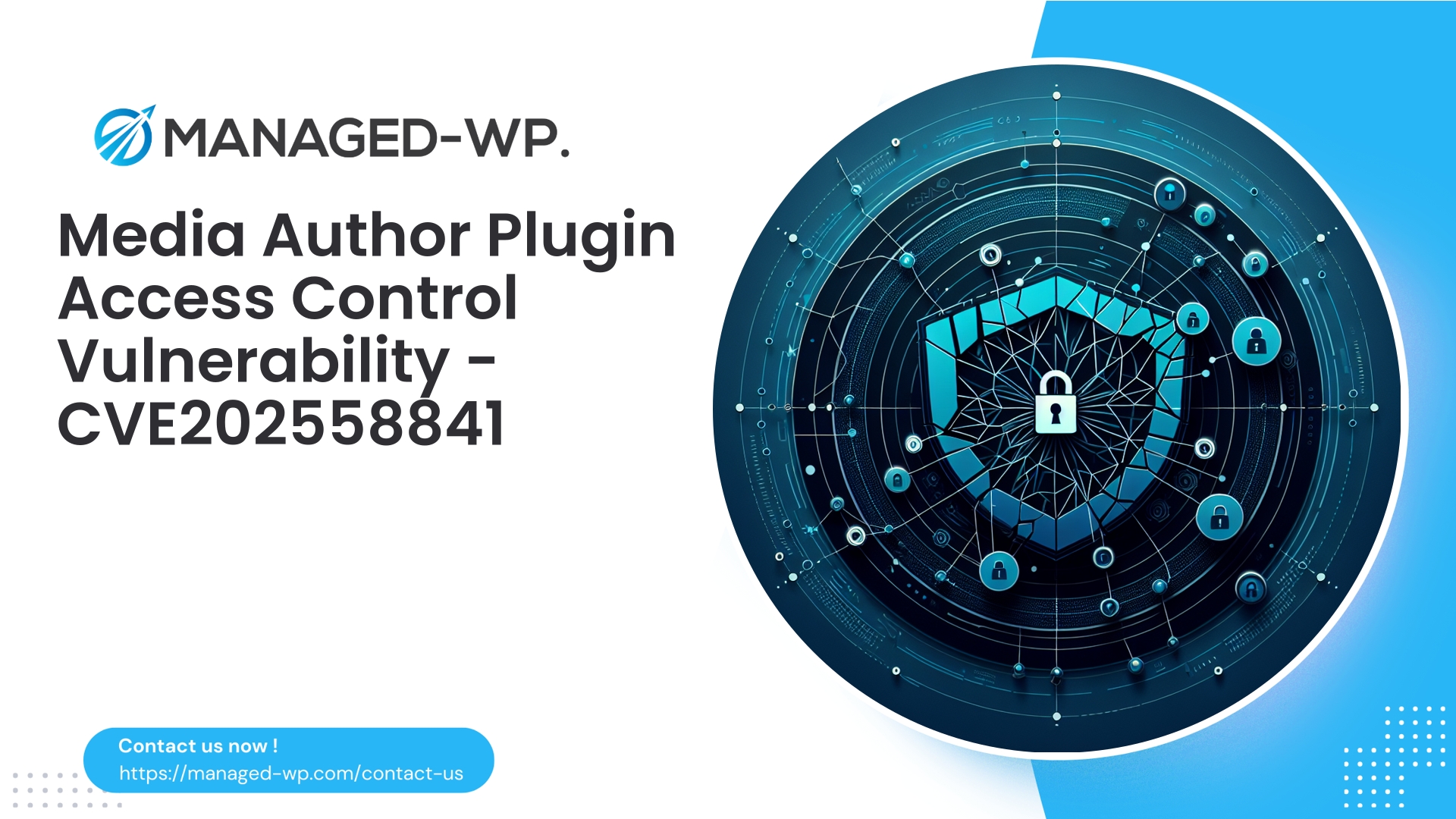| 插件名称 | eDS响应式菜单 |
|---|---|
| 漏洞类型 | PHP对象注入 |
| CVE编号 | CVE-2025-58839 |
| 紧急 | 低的 |
| CVE 发布日期 | 2025-09-05 |
| 源网址 | CVE-2025-58839 |
CVE-2025-58839:eDS响应式菜单(≤ 1.2)中的PHP对象注入漏洞——来自Managed-WP安全专家的重要指导
作者:Managed-WP 安全团队
日期:2025年9月5日
2025年9月5日,一个影响WordPress插件的重大安全漏洞(CVE-2025-58839)被公开披露。 eDS响应式菜单 适用于所有版本,包括 1.2 及更早版本。此缺陷被归类为 PHP对象注入(POI) 漏洞——这是一个严重的风险,攻击者可以利用它执行未经授权的代码、提升权限等等,前提是环境中存在合适的工具或 POP 链。遗憾的是,该插件似乎已被弃用,目前没有官方补丁可用。利用此漏洞需要管理员权限,这虽然降低了未经身份验证的远程攻击风险,但仍然构成严重威胁,尤其是在已被入侵的环境中。
作为一家总部位于美国的网络安全专业公司,Managed-WP 专注于 WordPress 安全防护,现提供一份清晰且切实可行的漏洞分析报告。我们的目标是帮助 WordPress 网站所有者、站长和开发人员快速了解风险并实施有效的防御措施。
要点总结:每个 WordPress 管理员都应该知道的知识
- 漏洞: eDS响应式菜单插件版本≤1.2中的PHP对象注入(CVE-2025-58839).
- 攻击要求: 攻击者必须拥有管理员权限才能触发该漏洞。
- 潜在影响: POI 可被利用,导致远程代码执行、SQL 注入、文件篡改或通过 gadget 链拒绝服务。
- 地位: 该插件似乎已停止维护;截至发稿时,尚未有官方修复方案。
- 建议采取的措施: 立即移除或替换该插件,使用强凭据和双因素身份验证保护管理员帐户,进行彻底扫描,并通过 WAF 解决方案部署虚拟补丁。
理解 PHP 对象注入 (POI):通俗易懂的解释
PHP 对象注入是指应用程序向某个对象注入 PHP 对象。 反序列化()未经适当验证或限制的数据会被直接使用。反序列化会将存储的字符串转换回 PHP 对象或变量。如果攻击者篡改了这些序列化的输入,他们就可以将恶意属性注入到网站 PHP 代码中已定义的类对象中。
这些注入的对象可能会调用“魔法方法”,例如 __wakeup() 或者 __destruct()这可能导致诸如文件创建、命令执行或数据库查询等意外行为。这些操作序列通常被称为“工具链”或面向属性编程 (POP) 链,它们会放大 POI 可能造成的损害。
需要掌握的核心概念:
- 序列化数据: 表示 PHP 对象或数组的结构化字符串格式。
- 不受信任的输入: 任何受用户影响的数据,包括 POST 参数、cookie 或用户选项。
- 小工具链: 一系列代码例程,当通过反序列化触发时,会执行恶意操作。
由于 WordPress 插件和主题通常使用面向对象的 PHP,因此如果存在小工具链,不安全的 unserialize() 调用可能会使整个网站面临被入侵的风险。
即使只需要管理员权限,这个漏洞仍然令人担忧。
表面上看,需要管理员权限才能利用漏洞似乎会降低紧迫性。但请考虑以下几点:
- 管理员帐户是网络钓鱼、密码重用或暴力破解等手段窃取凭证的主要目标。
- 一旦攻击者攻破了管理员权限,这个漏洞就可以被连锁利用,导致整个网站被完全控制或后门持久化。
- 恶意内部人员或先前已被攻破的管理员可能会利用此漏洞来提升控制权。
- 该插件的弃用意味着,如果没有官方的补救措施,风险仍然存在。
因此,即使未经身份验证的远程黑客攻击的几率降低了,但现实世界的风险仍然很高。
技术细节:eDS响应式菜单插件(≤ 1.2)
- 插件: edDS响应式菜单(WordPress)
- 受影响的版本: ≤ 1.2
- 漏洞: PHP 对象注入(OWASP 注入类别)
- CVE: CVE-2025-58839
- 要求: 利用管理员权限
- 补丁状态: 暂无可用插件,该插件似乎已停止维护。
- 发现: 独立报道并负责任地披露
目前尚无官方补丁;网站所有者必须立即采取防御措施。
漏洞利用机制概述(概念性)
- 该存在漏洞的插件在验证或访问控制不足的情况下反序列化数据。
- 拥有管理员权限的攻击者通过选项、设置导入或 POST 请求提供精心构造的序列化对象。
- 反序列化会将恶意构造的属性实例化为 PHP 对象。
- 如果服务器环境包含可利用的小工具链,这些对象会触发意外操作,例如文件写入、命令执行或数据库操作。
- 结果可能包括篡改内容,甚至完全入侵服务器。
具体攻击方式取决于网站的特定类和 PHP 版本,这使得检测变得复杂,但也凸显了主动防御的必要性。
入侵迹象 (IoC) 及检测技巧
如果您正在运行受影响的插件,请注意以下可疑迹象:
- 意外更新
wp_options表格,尤其是包含可疑或混淆的序列化数据的表格。 - 未知的新管理员帐户或已更改的用户角色/权限。
- 上传文件或插件目录中存在不熟悉的 PHP 文件。
- 意外的计划任务或定时任务。
- 来自您网站的异常外部网络请求。
- 修改了主题文件或 .htaccess 文件,添加了不寻常的代码或规则。
- 错误日志中引用了 unserialize() 或未知类名。
扫描建议:
- 使用文件完整性检查器将当前文件与最新的 WordPress 核心和主题包进行比较。
- 在数据库中搜索可疑的序列化字符串,特别是那些以“
O: :"类名". - 利用日志插件或主机日志来审核最近的管理员更改。
- 运行信誉良好的恶意软件扫描程序,并考虑使用其他工具进行全面扫描。
笔记: 误报很常见;请仔细调查可疑结果,如果怀疑网站遭到入侵,请隔离您的网站。
场地所有者应立即采取的缓解措施
- 验证是否存在存在漏洞的插件:
- 前往控制面板 → 插件 → 已安装插件。检查 eDS 响应式菜单版本 ≤ 1.2。
- 如果无法立即删除,请确保管理员帐户安全:
- 暂时禁用未知管理员帐户。
- 重置所有管理员密码,强制使用强密码和唯一密码。
- 启用双因素身份验证并限制远程管理员访问权限。
- 尽快移除插件:
- 通过插件控制面板停用并删除 eDS Responsive Menu。
- 如果删除操作延迟,则阻止对插件端点的访问:
- 应用服务器级拒绝规则或 IP 限制。
- 使用 Web 应用程序防火墙 (WAF) 过滤针对插件的攻击载荷。
- 轮换所有关联凭证:
- 更新管理员密码、数据库凭据、FTP、主机面板和 API 令牌。
- 备份您的整个网站:
- 在进行任何修复之前,请先对文件和数据库进行离线备份。
- 扫描恶意软件和后门:
- 进行全面的文件和数据库扫描;如有必要,寻求专业事件响应服务。
- 密切监控日志:
- 密切监控访问和活动日志,以发现可疑的管理员行为。
- 考虑将您的网站隔离:
- 如果怀疑存在安全漏洞,则转移到测试环境进行详细检查。
开发者避免POI漏洞的建议
- 避免对用户输入使用 unserialize() 函数:
- 使用 JSON 序列化(
json_encode/json_decode) 它不会实例化对象。
- 使用 JSON 序列化(
- 如果必须使用 unserialize(),请限制类:
- 请使用 PHP 7 或更高版本
反序列化($data,['allowed_classes'=> false])禁用对象实例化。 - 或者定义一个严格的允许类白名单。
- 请使用 PHP 7 或更高版本
- 验证并清理所有输入数据:
- 未经明确验证,切勿信任 POST、GET、cookie 或选项数据。
- 强制执行能力检查和随机数:
- 确保管理员级别操作检查
current_user_can('manage_options')并验证随机数。
- 确保管理员级别操作检查
- 限制魔法方法的副作用:
- 避免在内部进行文件写入或外部调用
__wakeup()或者__destruct().
- 避免在内部进行文件写入或外部调用
- 使用预处理语句进行数据库查询:
- 采用
$wpdb->prepare()防止 SQL 注入。
- 采用
- 记录关键管理员更改并通知网站所有者:
- 对关键选项和用户更新实施监控和电子邮件提醒。
插件作者应发布更新,移除不安全的 unserialize() 用法,并提供清晰的升级说明。
通过 Web 应用防火墙 (WAF) 进行虚拟修补的重要性
当官方补丁不可用时,通过 Web 应用防火墙 (WAF) 应用虚拟补丁是阻止 Web 层漏洞利用的最快方法。虚拟补丁无需修改插件文件即可阻止恶意请求到达易受攻击的代码。
针对兴趣点漏洞的典型WAF保护措施包括:
- 阻止包含可疑序列化 PHP 对象的请求。
- 过滤未经管理员授权的对易受攻击的插件端点的 POST/PUT 调用。
- 限制重复的可疑请求。
- 将管理员操作限制在已验证的会话或 IP 地址范围内。
- 实时提醒网站管理员注意攻击企图。
注意:虚拟补丁可以降低风险,但不能取代移除或更换插件的必要性。
Managed-WP 如何保护您的网站免受此漏洞攻击
Managed-WP 提供全面的 WordPress 安全服务,旨在立即保护您并保障您的未来安全:
- 自动虚拟补丁:
- 我们部署了自定义 WAF 规则,以阻止针对 eDS 响应式菜单和类似 POI 向量的序列化对象注入攻击尝试。
- 持续托管防火墙保护:
- 始终开启的规则可保护插件和管理端点免受未经授权的访问。
- 深度恶意软件扫描和清理工具:
- 检测异常 PHP 文件、注入的后门和可疑的代码更改。
- 管理员账户加固和监控:
- 跟踪管理员用户活动,并在出现可疑行为时发出警报。
- 事件响应支持:
- 为更高层级的计划提供专家协助,以高效地对违规行为进行分类和补救。
Managed-WP 客户应立即采取的步骤:
- 在您的控制面板中启用虚拟补丁和严格的WAF规则。
- 运行恶意软件扫描并查看标记的问题。
- 启用管理员监控和警报通知。
初次使用 Managed-WP?注册我们的免费套餐,即可在评估其他安全需求的同时,获得基本保护。
立即使用 Managed-WP 的免费保护计划,保护您的网站安全
使用 Managed-WP 的基础免费套餐,无需任何前期费用即可保护您的 WordPress 网站。该套餐包含托管防火墙、高效的 WAF 虚拟补丁、无限流量处理以及恶意软件扫描器,可缓解包括 CVE-2025-58839 等 POI 威胁在内的常见漏洞。立即开始: https://my.wp-firewall.com/buy/wp-firewall-free-plan/
如需增强安全自动化功能,请了解我们的标准版和专业版,它们提供自动恶意软件清除、黑名单、详细报告和高级支持。
管理员综合整改检查清单
- 已安装插件和用户帐户清单:
- 确认 eDS 响应式菜单的安装情况和版本。
- 列出 WordPress 网站上的所有管理员和服务帐户。
- 短期遏制措施:
- 如果可行,请将网站置于维护模式。
- 停用并删除存在漏洞的插件。
- 如果无法立即删除,则通过 IP 地址限制 wp-admin 访问权限。
- 凭证和访问管理:
- 强制所有管理员和特权用户重置密码。
- 对所有管理员账户强制执行双因素身份验证。
- 轮换 WordPress 使用的所有数据库凭据和 API 密钥。
- 备份:
- 在进行更改之前,请创建文件和数据库的完整离线备份。
- 恶意软件清理和验证:
- 扫描恶意软件或后门;清除已识别的威胁。
- 检查是否存在注入的或未知的 PHP 文件以及可疑的数据库条目。
- 撤销任何可疑行为
wp_options或者wp_usermeta进入受信任状态。
- 持续监测和加固:
- 启用 Managed-WP 的 WAF、安全扫描和加固功能。
- 启用管理员活动详细日志记录。
- 定期安排安全审计和漏洞扫描。
- 长期战略:
- 用积极维护的替代插件替换已停止维护的插件。
- 遵循开发者最佳实践,修复所有依赖不安全 unserialize() 用法的自定义代码。
- 事件响应:
- 对于无法解决或严重的安全隐患,请聘请专业事件响应人员。
- 如果持久化机制根深蒂固,请考虑对整个网站进行重建。
怀疑发生违规行为时应采取的步骤
- 立即将受影响的站点与公共网络隔离(如果可能,使其离线)。
- 保留所有日志并创建取证备份以供调查。
- 聘请一支合格的 WordPress 事件响应团队。
- 从干净的备份中仔细恢复,确保解决根本问题。
- 根据事件响应计划,通知相关利益方和托管服务提供商。
废弃插件的危害以及如何将风险降至最低
虽然插件可以扩展 WordPress 的功能,但废弃的插件会成为严重的安全漏洞:没有安全补丁,兼容性问题日益增多,并且由于代码重用或链接而扩大攻击面。
降低风险的方法:
- 选择维护活跃且更新日志透明的插件。
- 定期审核已安装的插件,并删除未使用的插件。
- 在生产环境部署之前,先在测试环境中测试更新。
- 制定回滚计划并保持频繁备份。
结语:时刻保持警惕是 WordPress 安全的关键
CVE-2025-58839 强调了 PHP 对象反序列化漏洞在与维护不善的代码和暴露的管理员帐户结合使用时,如何迅速升级为重大安全事件。
请通过以下方式保护您的网站:
- 今天移除或替换已弃用的插件。
- 使用强身份验证保护管理员帐户。
- 立即通过功能强大的WAF部署虚拟补丁。
- 实施持续监控、日志记录和定期安全审计。
Managed-WP 团队致力于通过专业的工具和个性化的支持,帮助 WordPress 网站所有者应对此类威胁。如果您在虚拟补丁实施、恶意软件扫描或安全网站重建方面需要帮助,请联系我们。
保持警惕,严格控制管理员权限,并将废弃插件的移除作为首要任务。
— Managed-WP 安全团队
参考资料及延伸学习
需要专业帮助?请登录您的 Managed-WP 控制面板或访问 https://my.wp-firewall.com/buy/wp-firewall-free-plan/ 立即开始使用我们的免费保障计划。











